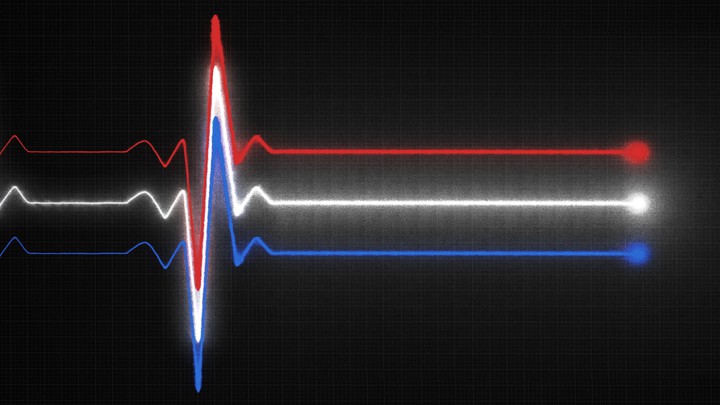How Many Americans Are About to Die?
A new analysis shows that the country is on track to pass spring’s grimmest record
The U.S. health-care system has not reduced the deadliness of the coronavirus since July, according to a new estimate by a prominent COVID-19 researcher, which accounts for the lags in public reporting of cases and deaths. Instead, the virus has, with ruthless regularity, killed at least 1.5 percent of all Americans diagnosed with COVID-19, over the past four months.
This rate is a major improvement, down more than tenfold from the earliest days of the pandemic, when deaths were high and the extreme limits on coronavirus testing held down the number of diagnosed cases. But in this new phase of the pandemic, when testing is more widely available and a much higher proportion of cases are diagnosed to begin with, it is also terrible, terrible news.
The problem described by these numbers is not abstract. Some officials in the Trump administration continue to fight reasonable attempts to slow the spread of the virus. Over the past two weeks, the increase in reported coronavirus cases has jumped to record highs. Now the country must face a simple but devastating question: How many people will die in the coming days, just weeks before the first vaccines begin to roll out?
The relationship between coronavirus cases and death might be the most important fact about COVID-19 outbreaks, but it has been one of the hardest to pin down. At the most basic level, it is impossible to say how many people in the U.S. have become infected. Most studies suggest that the infection fatality rate, or the number of people who die divided by the total number of infections (diagnosed or not), is now substantially less than 1 percent, with wide variation between the young and old. And we also know that we confirm only some fraction of the total number of infections.
A case of COVID-19 can be confirmed only by a polymerase chain reaction, or PCR, test—the type of test that laboratories have offered since the spring. But in the early months of the pandemic, the U.S. failed to ramp up testing as the virus spread, so only a small percentage of sick people were tested. In the spring, an enormous outbreak hit the New York metro area, infecting perhaps 20 percent of all New Yorkers, more than 1.6 million people. But up through mid-May, as the initial outbreak wound down, fewer than 200,000 cases were confirmed with PCR tests. (Almost 16,000 people had died in New York City alone by then.)
/media/img/posts/2020/11/image_30/original.png)
Some people in this country, including those in the highest echelons of our government, like Scott Atlas, the Stanford radiologist who now sits on the coronavirus task force, have done everything they can to play down the danger of the virus in the United States. However, in spite of improvements, COVID-19 remained deadly long after the spring: More people have died since June 15 than died before that date, even though the outcome of cases in general has improved. On average, more than 850 Americans have died on average since July 11, back when case numbers were a quarter of what they are now.
This month, Bedford saw case numbers rising quickly and began to ask the obvious question: How many people might die during the third surge? Using data from the COVID Tracking Project, he built a simple method to analyze the death rate. He knew that because COVID-19 kills people slowly, often after days or weeks in the hospital, reported deaths lag behind confirmed cases. State health departments make the lag even longer: They are buckling under the strain of the pandemic, and it takes days, at least, for a person who has died alone in a hospital to be counted among the official death statistics.
But the data are not available to make precise calculations of that lag. So Bedford looked at state-level data to find the best match between case numbers in the past and death numbers some days later. What he found was that plotting the seven-day average of deaths today and the seven-day average of cases 22 days ago maximized the correlation between cases and deaths. At the national scale, you can see how well these numbers parallel each other in the chart below.
/media/img/posts/2020/11/image_31/original.png)
Once Bedford settled on this lag period—which roughly squared with a CDC estimate from the summer—he wanted to know how many of the cases reported 22 days ago would translate into deaths. He called this simple calculation of deaths today divided by cases a few weeks ago the “lagged case-fatality rate.” Then he calculated it going back in time.
/media/img/posts/2020/11/image_32/original.png)
Case numbers have nearly quadrupled since late September, when roughly 700 people a day were dying. If 1.8 percent of confirmed cases are translating into recorded deaths 22 days later, the U.S. is about to enter some extremely harrowing days. Every 100,000 cases would mean roughly 1,800 dead Americans a few weeks later.
“I expect the U.S. to be reporting over 2,000 deaths per day in three weeks’ time,” Bedford concluded. “Importantly, this doesn’t assume any further increases in circulation and is essentially ‘baked into’ currently reported cases and represents conditions that take time to resolve and to be reported.”
And this analysis does not factor in new dynamics that could make outcomes worse, such as the possibility that local hospital systems collapse, which many health-care workers and experts are warning about. Already, more than 20 percent of hospitals are anticipating a staff shortage this week—and the Mayo Clinic reported that 900 of its workers had tested positive in the past two weeks. Nor does the analysis incorporate the possibility of an overburdened testing system becoming unable to complete as many tests as necessary, which would depress case counts. Either of these factors could push or skew the expected death rate even higher.
This is an extraordinary estimate—and it cuts sharply against the consensus forecasts of how many deaths we should expect. The CDC has a forecasting program that takes in dozens of forecasts. These are then synthesized into an “ensemble model” that has proved to perform better than any individual model at forecasting COVID-19 deaths. When Bedford made his initial investigations, for the week ending on December 5, the ensemble model’s most likely prediction was 8,606 deaths, or 1,230 deaths a day. The absolute outer edge of its prediction cone was 13,416, or 1,917 deaths a day. Bedford’s method predicts more than 14,000 deaths that week, outside the range that’s supposed to capture 95 percent of future possibilities. This was such a dire prediction that we immediately began to try to poke holes in Bedford’s work.
The most obvious source of overprojection would be that Bedford’s average over the past few months could be too high for these coming weeks. When we analyzed the different lagged fatality rates for recent days, we found that 1.7 percent (or even 1.6 percent) seemed to fit current COVID Tracking Project data the best, rather than the 1.8 percent that Bedford calculated over the data since July.
/media/img/posts/2020/11/image_7/original.png)
But these three projection lines, along with a fourth depicting an even lower, 1.5 percent death rate, show deaths continuing to rise rapidly. At a 1.8 percent death rate, we might hit 2,000 deaths a day on December 1. At a 1.5 percent death rate, we’d cross that threshold on December 5. The core proposition held: No matter how we plotted these numbers, if there was anything like the recent consistent relationship between cases at some point in the past and deaths today, deaths would rise far more than the ensemble model thinks is likely.
But this approach does not change the most important prediction. The country will still cross the threshold of 2,000 deaths a day, and even more quickly than Bedford originally predicted. Cases were significantly higher 16 days ago than 22 days ago, so a shorter lag time means that those higher case numbers show up in the deaths data sooner. Even with a lower case-fatality rate, deaths climb quickly. Estimating this way, the country would hit an average of 2,000 deaths a day on November 30.
/media/img/posts/2020/11/image_33/original.png)
The other major finding in Tibshirani’s analysis is that the individual assumptions and parameters in a Bedford-style model don’t matter too much. You can swap in different CFRs and lag-time parameters, and the outputs are more consistent than you might expect. They are all bad news. And, looking retrospectively, Tibshirani found that a reasonable, Bedford-style lagged-CFR model would have generated more accurate national-death-count predictions than the CDC’s ensemble model since July.
This is not a total surprise. The ensemble model has tended to perform well at moments when the pandemic was proceeding along the path of previous weeks, but this synthesis of forecasts has missed major turning points. Making a forecasting model that can work over long periods is very difficult.
The Bedford model might not hold up long term. It certainly is not a real forecasting model like the ones at the CDC, as Bedford freely admits. But it captures a crucial and counterintuitive dynamic of reality right now: For all our talk of better treatments and more widespread testing, we do not yet see evidence that those factors have led to major declines in the death rate over the past three months. And Bedford’s model doesn’t have to hold up until next March. If the statistical relationships he’s identified hold for just a few weeks, the country will be seeing spring-level deaths.
That’s not even taking into account the idea that the standard of care is likely to fall in places experiencing major surges. Treatment of severe COVID-19 is an intricate and laborious process; understaffed and exhausted units are unlikely to sustain the level of care that has improved the case-fatality rate.

In the most recent CDC ensemble forecast, released on Monday, the model has begun to predict far more deaths. And yesterday states reported 1,869 deaths, the most single-day fatalities in more than six months. This marked an increase of 330 deaths from last Wednesday—a significant and unusually large jump—but it was very close to what the 1.7 percent CFR Bedford model predicted.
These projections, while rough and packed with uncertainties about the precise numbers, lend more weight to the story that’s playing out across the county: The pandemic is out of control and many, many people are dying. The longer we continue along our current path, the higher the death toll will rise.

